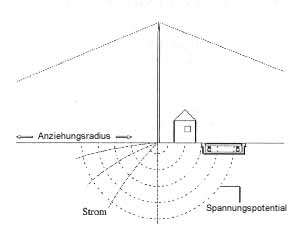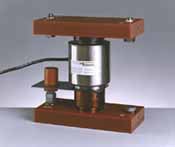In the event ofdirect or nearby lightning strikes to the buildings involved or parts of the weighing system, the possibility of damage cannot be completely ruled out. We recommend installing overvoltage protection for a location where the weighing bridge and weighing house are at risk of being struck by lightning.
Today, modernweighing systems are largely made up of powerful electronic components. However, this is precisely why they are particularly susceptible to damage caused by lightning strikes and overvoltage in general.
Ina joint study with load cell manufacturers and customers, HE Wägetechnik has specifically researched the problem of lightning damage to weighing systems. This information deals with fundamental questions on the subject of lightning protection and the installation of a lightning protection system.
Lightning strike

Heatthat accumulates on mountain slopes in full sunlight or cold air masses that push warm air ahead of them on their underside in a weather front generate air movements. As the warm air rises, it gradually cools down. A cloud is formed from water droplets and, at higher altitudes, from ice crystals. A thundercloud is such a system with higher air speeds than is normally the case. The powerful upward and downward currents in the center of the cloud generate static charges, with the ice crystals in the upper layers of the cloud being positively charged and the water droplets in the lower layers being negatively charged.
Thevoltage field generated between the charge centers causes the air molecules to ionize, creating a conductive channel that enables the discharge, i.e. the lightning. Most lightning flashes are discharges between two clouds. About 15 % are discharges between cloud and ground. In general, the charge concentration is highest at high or pointed points. Therefore, lightning between cloud and ground preferably strikes masts, towers, trees, etc. Once the ionization channel is established between the cloud and the ground, a conductive path is created that short-circuits the charge centers, thus enabling the main current flow or return stroke and restoring the balance between the charges. This current can induce voltages in power supply systems such as long (underground) cable runs parallel to the ground. Studies have shown that a lightning strike within 300 m of the geometric center of a weighbridge is certain to have a damaging effect on it. Furthermore, damage is not limited to lightning strikes to earth, as cloud-to-cloud lightning can also generate a sufficiently strong electromagnetic pulse to cause damage. Lightning strikes are discharge surges where the current and voltage are considerably higher than normal.
Damage caused by lightning strikes
At the heart ofmodern load cells are foil-like strain gauge resistors. These strain gages are manufactured by coating an epoxy or polyamide carrier with a thin film. A load cell normally consists of four (or a multiple of four) strain gages in the form of a Wheatstone bridge configuration. Several resistors are connected in series with the supply lines of the Wheatstone bridge.
Theseresistors compensate for temperature influences and are used to calibrate the load cell output signal. Strain gages and resistors can only withstand low voltages of no more than 15 or 20 volts. The dielectric strength of the foil carrier is approx. 400 to 500 volts. Overvoltage or overcurrent caused by lightning will destroy the load cell either: by damaging the resistors or strain gages, or by damaging the foil carrier that connects the bridge to the housing.
Inboth cases, the component may burn out completely, but not necessarily. It is possible that only a part of the load cell circuit or the bonding of one of the strain gages is damaged. In this case, the scale begins to work incorrectly and/or does not return to zero after being loaded. Sometimes these problems only occur weeks after the lightning strike! In addition to the load cells, damage can also occur to the measuring device (display unit/computer) and peripheral devices such as printers and card readers, especially if live cables have been struck in the immediate vicinity. As with the load cells, only a small part of the electronics may be damaged, such as RS232 connections or even just a few small tantalum capacitors. Minor damage that is overlooked immediately after the lightning strike can cause a display error. It is therefore essential to inspect the circuit boards carefully for damage or residues of burnt-out components.
Lightning protection
A distinction ismade between external and internal lightning protection. With external lightning protection, there is normally an earth connection between the steel roof of the control room in which the display unit is installed or another nearby structure or a high protective mast, so that a preferred discharge point is available via which the overvoltage is safely conducted to earth. This external lightning protection is quite controversial. On the one hand, a weighbridge or weighbridge in general is not a particular point of attraction for lightning strikes, but a 20 meter high mast has an attraction radius of 81 meters. This means that lightning that would strike a building or a tree at a distance of 60 m or more without such a mast will inevitably generate a surge (step voltage) in the immediate vicinity of the weighbridge! Without very strict precautions, such a surge will cause an electromagnetically induced pulse that can undoubtedly cause serious damage to the weighbridge.

| Effective height of the structure (m) | Attraction radius (m) |
| 5 | 30 |
| 10 | 50 |
| 15 | 67 |
| 20 | 81 |
| 25 | 95 |
| 30 | 108 |
| 35 | 132 |
| 40 | 155 |
The table above showsthe radius of attraction of a structure at a certain effective height for downward strokes. Masts to protect the weighbridge offer the only advantage that the lightning does not strike the weighbridge directly, but actually increase the risk of damage due to their lightning-attracting effect.
Internallightning protection consists of the creation of potential equalization within the entire substation through the use of protective devices and the construction of the weighbridge structure in the form of a Faraday cage. A Faraday cage is also built around the control room or measuring cabin. A relatively short distance between the two cages requires an earth connection, i.e. the potential of the entire system is always constant. Equipotential bonding is already included as standard in every HE Wägetechnik truck scale.
Allexternal connections, such as AC lines, communication connections and the signal/feed line, are a potential source of power surges and short-term overvoltages. It is therefore essential to install an overvoltage protection device at the input of the Faraday cage for each input or output line to ensure lightning protection.

Toprotect the load cells against step voltages, insulation is provided against the ground and the scale bridge. Although this ensures a high level of protection, it must be borne in mind that the load cell circuit can still theoretically be carried through and damaged by high currents induced by lightning. However, the occurrence of such a high potential difference that the foil carrier between the strain gauge and the housing can be damaged is unlikely. The insulating plates only fulfill their function if they are well protected against moisture; as soon as the plates are flooded, the insulation resistance drops drastically. Therefore, good care and cleaning of the scales also protects against damage caused by lightning!
Links to the topic
Lightning information service from Siemens
with BLITZ-SPION – the free overview of current thunderstorm activity.
www.blitz-radar.de
offers thunderstorm warnings with notification via SMS or email (free of charge)
and archive data retrieval on lightning strikes from a specific day (subject to charge).
Association of German Lightning Protection Companies
inform about lightning protection systems and specialist dealers.
Dehn + Söhne
offers a complete, coordinated product range for lightning and surge protection.





